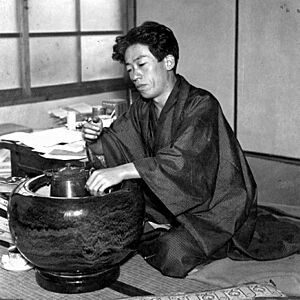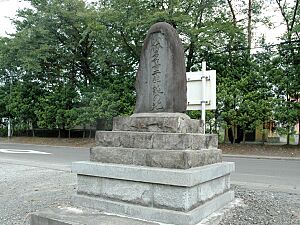Takiji Kobayashi facts for kids
Quick facts for kids
Takiji Kobayashi
|
|
|---|---|
 |
|
| Native name |
小林 多喜二
|
| Born | October 13, 1903 Odate, Akita, Japan |
| Died | February 20, 1933 (aged 29) Tokyo, Japan |
| Occupation | Writer |
| Genre | Novels |
| Literary movement | proletarian literature |
Takiji Kobayashi (born October 13, 1903 – died February 20, 1933) was a Japanese writer. He wrote about the lives of working-class people, a style known as proletarian literature.
He is most famous for his short novel Kanikōsen, also called Crab Cannery Ship. It was published in 1929. The story shows the difficult lives of workers on a crab canning ship. It also tells how they started to stand up against the company and its bosses.
Sadly, Takiji Kobayashi died at just 29 years old. He was arrested by the special police (called Tokkō) and died from severe treatment while in their custody.
The Life of Takiji Kobayashi
Takiji Kobayashi was born in Odate, Akita, Japan. When he was four, his family moved to Otaru, Hokkaido. His family was not rich. However, his uncle helped pay for his education. This allowed him to attend good schools, including what is now Otaru University of Commerce.
While studying, he became very interested in writing. He sent his essays to literary magazines. He also helped with his school's alumni magazine and had his own writings published. Around this time, because of money problems and a tough economy, he joined the labour movement. This movement worked to improve conditions for workers.
Early Career and Important Stories
After finishing school, Takiji worked at a bank in Otaru. In 1928, he helped with a political campaign. This experience later inspired his book Higashikutchankō.
In the same year, his story March 15, 1928 was published. This story was based on a real event where police arrested many people. It showed the harsh treatment by the Tokkō police. This made government officials very angry.
The Crab Cannery Ship and Other Works
In 1929, Takiji's novel Kanikōsen was published. It was about a crab-fishing ship's crew who decided to fight back against a cruel manager. The book quickly became well-known. It was seen as an important example of Marxist proletarian literature, which focuses on the struggles of the working class.
The story was even turned into a play in July 1929. The full version of Kanikōsen was not available in Japan until 1948. It has been translated into English and many other languages.
Also in 1929, Takiji published The Absentee Landlord. This book described the hard lives of farmers in Hokkaido. It showed their struggles with rich landowners. Japan was trying to develop Hokkaido's farming and industry at the time.
Facing Challenges and Arrest
The police, especially the Tokkō, started watching Takiji Kobayashi closely. When his new book Absentee Landlord was published, he lost his job at the bank.
In 1930, Takiji moved to Tokyo. He became a leader for a group of writers who focused on working-class stories. He was arrested several times for supposedly supporting the Japanese Communist Party. This party was not allowed at the time. He was also charged because of his book Kanikōsen.
In 1931, he was released from prison. He then joined the outlawed Japan Communist Party. He had to go into hiding in 1932 to avoid the police.
His Death
On February 20, 1933, Takiji Kobayashi went to a secret meeting in Akasaka, Tokyo. The person he was meeting turned out to be a spy for the Tokkō police. The police were waiting for him. He tried to escape but was caught and arrested.
Takiji was taken to the Tsukiji Police Station. He was treated very badly there. The next day, police said he died of a heart attack. No hospital would perform an autopsy (a check of the body to find the cause of death) because they were afraid of the Tokkō police.
Takiji Kobayashi's Lasting Impact
A Bestseller in 2008
In 2008, Kanikōsen became a surprise bestseller in Japan. This happened because an advertising campaign connected the novel to the struggles of working people today.
Translated Around the World
Takiji Kobayashi's main books have been translated into many languages. These include Russian, Chinese, English, Korean, Spanish, French, and German. This shows how his stories have reached people all over the world.
Remembering Takiji
Groups of people who admire Takiji Kobayashi often hold events to remember him. These events, called "Takiji Sai," often include music and talks about his life and works. They are usually held in places important to his life, like Otaru and Akita.
A Musical Play
Suite Slaughter is a musical play written by Inoue Hisashi. It tells the story of Takiji Kobayashi's life from 1930 until his death. The play opened in Tokyo in 2009 and won several awards.
The Takiji Library
A special place called the Takiji Library was created by a businessman who went to Takiji's old school. This library became a central place for information about Takiji. It has helped publish books, including a manga (Japanese comic) version of The Cannery Ship.
A Documentary Film
Strike the Hour, Takiji is a documentary film about Takiji Kobayashi's life. It was released in 2005.
Otaru Literary Museum
The Otaru Literary Museum features several Japanese writers, including Takiji Kobayashi. You can even see a bronze mask of his face there. The museum has seen more visitors because of the popularity of Kanikōsen.
Visiting Places from His Life
The popularity of Kanikōsen has also brought excitement to Otaru city. This city is where Takiji Kobayashi is buried and is considered his hometown. There are books that guide fans on "literary walks" to visit places important to Takiji. There are even bus tours that visit the Otaru Literary Museum and Takiji Kobayashi's gravesite.
Takiji Kobayashi Literary Monument
On October 9, 1965, a monument to Takiji Kobayashi was revealed. It was built by the Japanese sculptor Hongo Shin. The monument stands at the Asahi observatory, looking over Otaru City.
Main Works
- Kanikōsen (Crab Cannery Ship)
- March 15, 1928
- Yasuko
- Life of a Party Member
- The Absentee Landlord
- The Dogs That Kill Men
See also
 In Spanish: Takiji Kobayashi para niños
In Spanish: Takiji Kobayashi para niños
- Japanese dissidence during the Shōwa period


